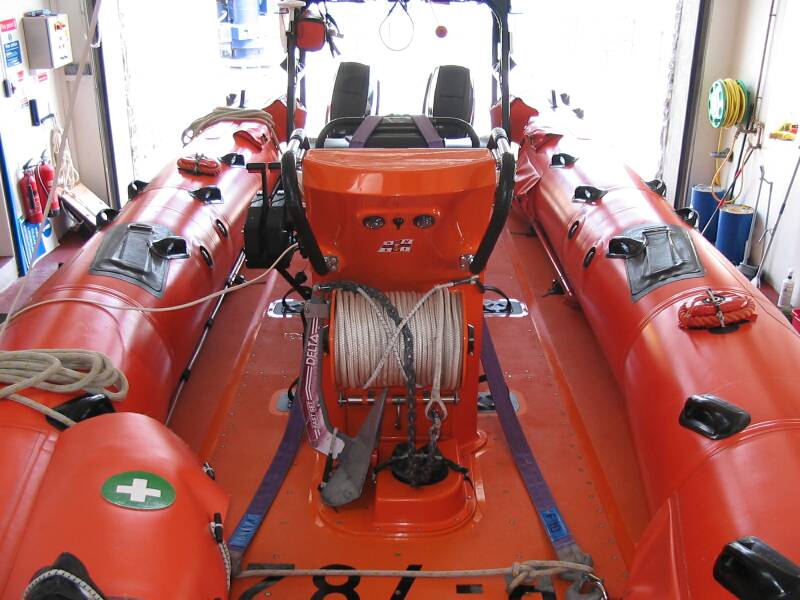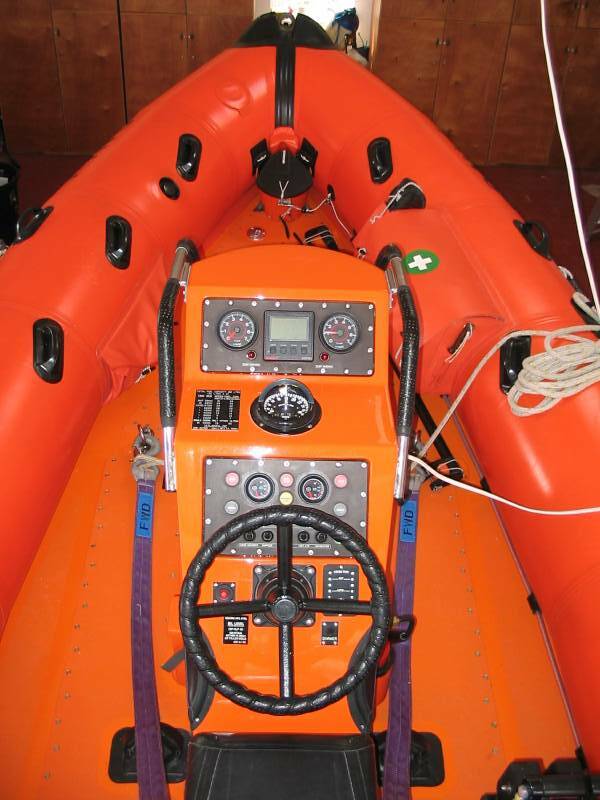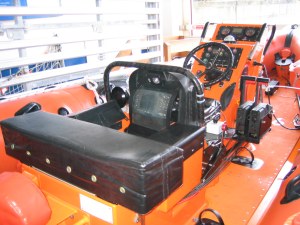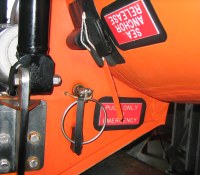Our Lifeboat
B-782 Miss Betty has arrived and will be our station lifeboat for many years to come. The "B" indicates an Atlantic Class inshore lifeboat. The boat numbers from 700 up, i.e. 718, indicate an Atlantic 75. The boat is 7.3m long, originally fitted with twin Evinrude 70hp outboard engines but now has twin Yamaha 75hp engines. Carrying a crew of three, the boat has a top speed of 31kts and an operating limit of three hours.
Our first station boat was B-575 "John Batstone". She arrived on 3 April 2000 when our training began. Despite a brief period with B-525 "Spix's Macaw", we had her on station up to 22 May 2002 when the relief 75 B-718 "Rotaract I" arrived. Rotaract I was part of the relief fleet and was used in training many of the crews of the new Thames E-class boats as well as us!
The RNLI has a fleet of about 80 "B" class lifeboats, stationed on inland waters (Enniskillen & Lough Derg) and all around the coast. Our boat first lay afloat on the Royal Cork Yacht Club marina while we were waiting for our station to be built. Usually, the Atlantic is launched bows-first from a large trailer pushed down a slip or a beach by a four wheel drive waterproofed tractor. However, our boat is one of about five launched by crane or davit.
The Atlantics are built and maintained at the Inshore Lifeboat Center in Cowes. Hulls are built by Souters Marine, and the tubes by Avon. All the assembly and fit-out is completed in the ILC. Visit our photo gallery to see pictures of our new boat under construction.
To find out more about the lifeboat fleet, visit the RNLI's award winning website.
The story of B-575 "John Batstone"
Our first boat was commissioned on 13 February 1989 in Peel as their station boat. She was funded by Tim Batstone & named after his father. The funds were raised by a non-stop windsurfing trip around the Isle of Wight.
On 10 June 1992, Peel became an All-Weather station & B-575 was withdrawn to the relief fleet. She visited Mudeford and Newbiggin on relief duty (and spent time in the training fleet) before being sent to Trearddur Bay (a new Atlantic station) on 15 April 1996 on temporary station allocation. Three days later, she was capsized and returned to ILC for overhaul following the capsize. 1 April 1997 saw B-575 on temporary station allocation at Clifden, another new station. In 1998, she was hired to the London Metropolitan Police for their training requirements. In between, B-575 served in the training fleet in the ILC in Cowes, with many helms having qualified at her wheel. A new Millennium saw B-575 allocated to another new station - ours! She has now been returned to ILC Cowes to the relief fleet.
More on the Atlantic 75
The current Atlantic 75 class lifeboats, developed at the RNLI's Inshore Lifeboat Centre at Cowes, are the fastest coastal boats in the fleet, with a maximum speed of 34 knots provided by the twin 75hp outboard engines. The boat has an overall length of 24ft (7.3m), width of 8ft 8in (2.64m) and a draught at rest of only 26in (0.66m). She can be righted by means of a gas buoyancy bag on a framework above the engines and has been fitted with a new type of water ballast system which may be emptied and filled while at sea.
Hull
The rigid portion of the hull is made of GRP (Glass Reinforced Plastic), a composite material consisting of plastic (polymer resin) with glass fibre reinforcement. This material is stronger than wood, non-corroding, invulnerable to attack by marine organisms and easily moulded into complex shapes. The hull is shaped with a deep V forward to a flat run aft, the deep V bow gives the boat excellent directional stability when underway and the flat run assists in getting the boat up on the plane quickly and on the occasion that the boat needs to be beached she will sit upright.
The bow contains ballast tanks which are filled with water to provide the boat with more stability and may be filled and emptied while at sea by the the use of a handle near the helmsman which lowers a scoop to fill the tanks while the boat is underway.
Two stainless steel fuel tanks are installed in the hull, one to port the other to starboard, both are embedded in polystyrene and can be used to feed each engine independently or one tank to both engines if needed. The tanks each hold 18 gallons of unleaded petrol/oil mixture (50:1) and will allow the boat to travel at full speed for about 3 hours, covering a distance of approximately 90 nautical miles.
Sponson
The sponson is the inflatable tube (made of Hypalon) which runs around the outside of the boat allowing the boat to operate in rough seas and provides fendering when going alongside other vessels. The sponson is composed of eleven separate compartments, if one is accidentally punctured then the others will remain inflated. Internal baffles will be blown into the punctured void, reducing the effect of the puncture. The boat is still capable of floating without the sponson.
Console
 The console is fitted in the centre of the boat and provides the helsman's controls and seating for the crew, with the helmsman at the front, and the radio operator behind him to the port side and other crew (navigator) to starboard. All crew positions have foot straps fitted to the deck to allow the crew to 'ride the bumps'. Although there are only three crew seats the boat is capable of carrying twenty two people if necessary.
The console is fitted in the centre of the boat and provides the helsman's controls and seating for the crew, with the helmsman at the front, and the radio operator behind him to the port side and other crew (navigator) to starboard. All crew positions have foot straps fitted to the deck to allow the crew to 'ride the bumps'. Although there are only three crew seats the boat is capable of carrying twenty two people if necessary.
At the very front of the console is the anchor, warp and chain, when deployed the anchor warp is passed through the fairlead at the bow which will ensure that the boat is always held head on, it also prevents wear on the sponson and will prevent the possibility of capsize caused by an anchor rope going over the side of a sponson.
 The helmsman has control of the steering wheel and single hand operation of the engine controls (throttles, gears and engine tilt/trim). Also on the helmsmans console are the illuminated compass, depth sounder, various switches for controlling navigation lights, engine start/stop, individual tachometers and motor temperature warning lights.
The helmsman has control of the steering wheel and single hand operation of the engine controls (throttles, gears and engine tilt/trim). Also on the helmsmans console are the illuminated compass, depth sounder, various switches for controlling navigation lights, engine start/stop, individual tachometers and motor temperature warning lights.
Behind the helmsman on the port side is the water-tight VHF radio, hand microphone and loudspeaker, (the helmsman also has a radio speaker and mike in his helmet which is controlled by a switch on the throttle handle). Directly behind the helmsman is the chartplotter (electronic navigation system) (although waterproof charts of the local area are stored in  pockets in the console in case necessary). The crew seat on the console can be lifted to gain access to the petrol tank filler caps and a locker for gear such as a foot pump for topping up the sponson and an aerosol operated fog horn. Rigging cutters are also carried. In another locker on the console a number of flares are stored, 2 red parachute flares for distress and 6 white parachute flares. The white flares are used when searching at night. They are fired into the air to produce a very bright light at 1,000 feet which slowly descends on a parachute illuminating a large area.
pockets in the console in case necessary). The crew seat on the console can be lifted to gain access to the petrol tank filler caps and a locker for gear such as a foot pump for topping up the sponson and an aerosol operated fog horn. Rigging cutters are also carried. In another locker on the console a number of flares are stored, 2 red parachute flares for distress and 6 white parachute flares. The white flares are used when searching at night. They are fired into the air to produce a very bright light at 1,000 feet which slowly descends on a parachute illuminating a large area.
To the rear of the console is the 35m towing rope on a reel which is used in conjunction with the tow bar (stored alongside the sponson) to tow stricken vessels to safety. The tow bar can be fitted to the a-frame at the stern of the boat and the tow rope then passed over it to provide a safe method of towing vessels while keeping the rope out of the lifeboat's propellors.
Roll-bar
 The roll-bar, also known as the a-frame or gantry, is located at the very stern of the boat and supports the self righting bag, navigation lights and aerials. It also provides mounting for the oxygen therapy unit and radar reflector. In the event of a capsize in very shallow water the roll-bar will give some protection to the crew, motors and console.
The righting bag is stored on top of the a-frame and may be inflated using CO2 cylinders located at the base of the rollbar. If the boat should capsize a handle at either side of the boat outside of the stern (ie, accessible from the water when the lifeboat is inverted) will empty the contents of one of the gas bottles into the airbag which will then cause the boat to roll the right way up.
The roll-bar, also known as the a-frame or gantry, is located at the very stern of the boat and supports the self righting bag, navigation lights and aerials. It also provides mounting for the oxygen therapy unit and radar reflector. In the event of a capsize in very shallow water the roll-bar will give some protection to the crew, motors and console.
The righting bag is stored on top of the a-frame and may be inflated using CO2 cylinders located at the base of the rollbar. If the boat should capsize a handle at either side of the boat outside of the stern (ie, accessible from the water when the lifeboat is inverted) will empty the contents of one of the gas bottles into the airbag which will then cause the boat to roll the right way up.
Engines
The twin 70hp engines are capable of taking the boat to a speed of 34 knots, both are petrol/oil mixture two stroke, water cooled powering stainless steel propellers. The engines may be operated completely independently of each other if required. The RNLI makes extensive modifications to the engines to inversion proof them:
six mercury tilt switches operate mechanisms to shut off the air inlet, cut off the engines, lock the engine tilt mechanism and turn on capsize lights if the boat reaches an angle of heel of 90 degrees
the exhaust system has a u-tube assembly and one way exhaust valves to prevent water entering when the engine is inverted
A closed carburettor system is used to prevent fuel leakage
The engines undergo fortnightly maintenance to ensure they start first time, each time, and can be restarted following a capsize.
Other equipment
First aid kit
Portable VHF radio
Night vision scope
3 x Paddles (one strengthened for use in emergency steering)
4 x knives
Toolkit
2 x Spare propellers
Sea Anchor (stored at bow of boat used for holding the head of the boat into the sea in case of capsize or when normal anchor would not be applicable)
Throwing lines fitted to quoits at either side of the sponson
2 x 20m mooring ropes
2 x Small hand held torch
Halogen 12v searchlight
Fire extinguisher
 The console is fitted in the centre of the boat and provides the helsman's controls and seating for the crew, with the helmsman at the front, and the radio operator behind him to the port side and other crew (navigator) to starboard. All crew positions have foot straps fitted to the deck to allow the crew to 'ride the bumps'. Although there are only three crew seats the boat is capable of carrying twenty two people if necessary.
The console is fitted in the centre of the boat and provides the helsman's controls and seating for the crew, with the helmsman at the front, and the radio operator behind him to the port side and other crew (navigator) to starboard. All crew positions have foot straps fitted to the deck to allow the crew to 'ride the bumps'. Although there are only three crew seats the boat is capable of carrying twenty two people if necessary.
 The helmsman has control of the steering wheel and single hand operation of the engine controls (throttles, gears and engine tilt/trim). Also on the helmsmans console are the illuminated compass, depth sounder, various switches for controlling navigation lights, engine start/stop, individual tachometers and motor temperature warning lights.
The helmsman has control of the steering wheel and single hand operation of the engine controls (throttles, gears and engine tilt/trim). Also on the helmsmans console are the illuminated compass, depth sounder, various switches for controlling navigation lights, engine start/stop, individual tachometers and motor temperature warning lights. pockets in the console in case necessary). The crew seat on the console can be lifted to gain access to the petrol tank filler caps and a locker for gear such as a foot pump for topping up the sponson and an aerosol operated fog horn. Rigging cutters are also carried. In another locker on the console a number of flares are stored, 2 red parachute flares for distress and 6 white parachute flares. The white flares are used when searching at night. They are fired into the air to produce a very bright light at 1,000 feet which slowly descends on a parachute illuminating a large area.
pockets in the console in case necessary). The crew seat on the console can be lifted to gain access to the petrol tank filler caps and a locker for gear such as a foot pump for topping up the sponson and an aerosol operated fog horn. Rigging cutters are also carried. In another locker on the console a number of flares are stored, 2 red parachute flares for distress and 6 white parachute flares. The white flares are used when searching at night. They are fired into the air to produce a very bright light at 1,000 feet which slowly descends on a parachute illuminating a large area. The roll-bar, also known as the a-frame or gantry, is located at the very stern of the boat and supports the self righting bag, navigation lights and aerials. It also provides mounting for the oxygen therapy unit and radar reflector. In the event of a capsize in very shallow water the roll-bar will give some protection to the crew, motors and console.
The righting bag is stored on top of the a-frame and may be inflated using CO2 cylinders located at the base of the rollbar. If the boat should capsize a handle at either side of the boat outside of the stern (ie, accessible from the water when the lifeboat is inverted) will empty the contents of one of the gas bottles into the airbag which will then cause the boat to roll the right way up.
The roll-bar, also known as the a-frame or gantry, is located at the very stern of the boat and supports the self righting bag, navigation lights and aerials. It also provides mounting for the oxygen therapy unit and radar reflector. In the event of a capsize in very shallow water the roll-bar will give some protection to the crew, motors and console.
The righting bag is stored on top of the a-frame and may be inflated using CO2 cylinders located at the base of the rollbar. If the boat should capsize a handle at either side of the boat outside of the stern (ie, accessible from the water when the lifeboat is inverted) will empty the contents of one of the gas bottles into the airbag which will then cause the boat to roll the right way up.